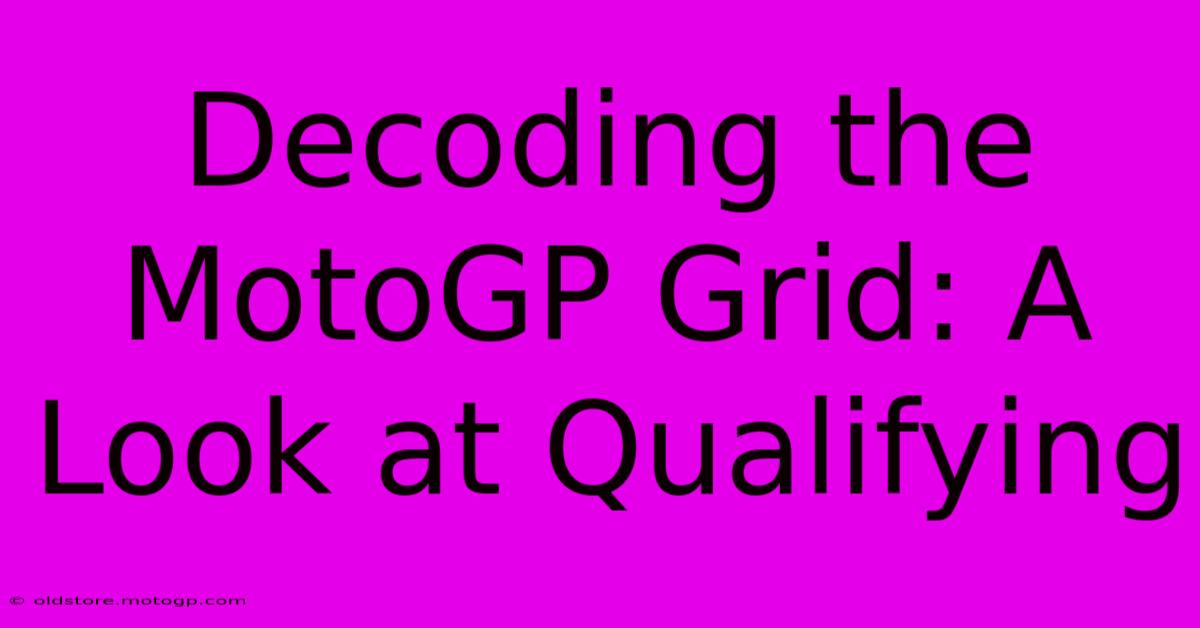Decoding The MotoGP Grid: A Look At Qualifying

Table of Contents
Decoding the MotoGP Grid: A Look at Qualifying
MotoGP, the pinnacle of motorcycle racing, boasts breathtaking speeds, nail-biting overtakes, and intense rivalries. But before the lights go out and the race begins, there's another crucial battle: qualifying. Understanding the MotoGP qualifying process is key to appreciating the drama unfolding on race day. This article will decode the intricacies of MotoGP qualifying, explaining the format, strategies, and factors that determine starting positions.
The Qualifying Format: A Breakdown
MotoGP qualifying is a multi-stage process designed to separate the wheat from the chaff. The current format comprises two sessions:
Q1 (Qualifying 1):
- Participants: The ten slowest riders from the combined Free Practice (FP) sessions 1, 2, and 3.
- Duration: 15 minutes.
- Objective: The two fastest riders from Q1 automatically progress to Q2. This session is often high-stakes, with riders pushing their limits to secure a place in the fight for pole position.
Q2 (Qualifying 2):
- Participants: The ten fastest riders from the combined Free Practice sessions, plus the two riders who qualified from Q1.
- Duration: 15 minutes.
- Objective: The grid positions for the top 12 riders are determined here. The rider with the fastest lap time earns pole position, securing the coveted starting spot at the front of the grid.
Strategies and Tactics: More Than Just Speed
While raw speed is paramount, MotoGP qualifying involves much more than simply riding as fast as possible on a single lap. Successful qualifying requires:
Tire Management:
Riders must carefully manage their tire wear. Pushing too hard in Q1 to secure a Q2 spot might compromise their performance in the crucial Q2 session. The choice of tire compound (soft, medium, or hard) also plays a vital role, balancing grip and longevity.
Track Conditions:
The ever-changing track conditions, including temperature and grip levels, influence tire choices and riding strategies. Riders and their teams constantly analyze data to optimize their performance in the prevailing conditions.
Slipstream:
Utilizing the slipstream (draft) of another rider can provide a significant speed boost, especially on straights. Strategic collaboration (or sometimes, aggressive blocking) is common among teams, though alliances can be fragile in the cutthroat world of MotoGP.
Race Setup vs. Qualifying Setup:
Finding the optimal balance between a race setup (focused on consistent lap times over many laps) and a qualifying setup (optimized for one blistering fast lap) is a crucial challenge. Some compromises may be needed to optimize performance.
Factors Influencing Qualifying Performance
Beyond rider skill and strategy, several other factors significantly influence qualifying performance:
- Bike Performance: The inherent capabilities of the motorcycle, including engine power, chassis dynamics, and aerodynamic efficiency, play a vital role. Technological advancements constantly shape the competitive landscape.
- Team Support: A skilled crew plays a critical role in setup, strategy and providing data-driven insights. The quality of the pit crew also impacts tire changes and fuel load.
- Weather Conditions: Rain, wind, or extreme temperatures can dramatically impact track conditions and qualifying strategies. Adaptability and the ability to make correct judgments under pressure are key.
The Importance of Starting Position
Securing a good starting position in MotoGP is of paramount importance. The front row offers a significant advantage, allowing riders to control the race pace and avoid being caught up in early-race incidents. A poor starting position, on the other hand, can severely hamper a rider's chances of a top result, increasing the risk of battles through the midfield.
Conclusion: A Complex Dance of Skill and Strategy
MotoGP qualifying is far more than a simple timed session. It's a complex interplay of skill, strategy, technology, and a bit of luck. Analyzing the qualifying results provides valuable insights into the relative strengths of riders and teams and often sets the stage for the electrifying races that follow. By understanding the nuances of the qualifying format, we can fully appreciate the drama, tension, and ultimately, the thrilling spectacle of MotoGP.

Thank you for visiting our website wich cover about Decoding The MotoGP Grid: A Look At Qualifying. We hope the information provided has been useful to you. Feel free to contact us if you have any questions or need further assistance. See you next time and dont miss to bookmark.
Featured Posts
-
Yamaha Moto Gp Racing The Importance Of Innovation
Feb 24, 2025
-
Moto Gps Finest Photoshoot Highlights
Feb 24, 2025
-
The Untamed Spirit Of American Moto Gp
Feb 24, 2025
-
Moto Gp Accident Examining The Track Conditions
Feb 24, 2025
-
Dont Miss Out Reserve Your Formula 1 Parking
Feb 24, 2025
